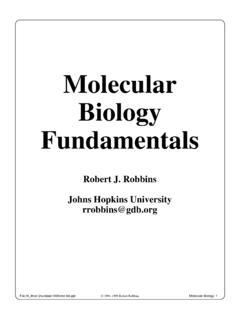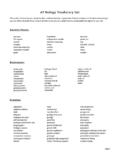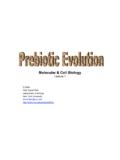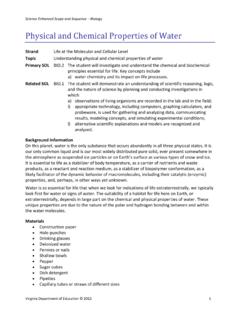Transcription of Energy and ATP - VDOE
1 Science Enhanced Scope and Sequence biology virginia department of education 2012 1 Energy and ATP Strand Life at the molecular and Cellular Level Topic Investigating Energy transfer and metabolism Primary SOL The student will investigate and understand the chemical and biochemical principles essential for life. Key concepts include d) the capture, storage, transformation, and flow of Energy through the processes of photosynthesis and respiration. Related SOL The student will demonstrate an understanding of scientific reasoning, logic, and the nature of science by planning and conducting investigations in which d) graphing and arithmetic calculations are used as tools in data analysis; e) conclusions are formed based on recorded quantitative and qualitative data.
2 Background Information Although adenosine triphosphate (ATP) is not the only Energy -storing molecule in cells, it is the most common. ATP is constructed from the RNA nucleotide adenine: Adenine + Ribose Sugar = A-P~P~P. The structure of ATP compares to the structures of ADP and AMP as follows: Adenosine triphosphate (ATP) has three phosphate groups attached to it: A-P~P~P. Adenosine diphosphate (ADP) has two phosphate groups attached to it: A-P~P. Adenosine monophosphate (AMP) has a single phosphate group: A-P. Note the high Energy bonds between the second and third phosphate groups. Adenosine triphosphate (tri = three) is the higher Energy form (like a recharged battery), while adenosine diphosphate (di = two) is the lower Energy form (like a used-up battery).
3 When the terminal, or third, phosphate is cut loose, ATP becomes ADP, and the stored Energy is released for use in some biological process. The input of additional Energy (plus a phosphate group) recharges ADP into ATP. Materials Rechargeable batteries Four blocks of wood of equal length, one twice as wide as the other three Colored markers Nine identical, long rubber bands Protective eyewear for all students Scissors Tape measure Vocabulary adenosine diphosphate (ADP), adenosine monophosphate (AMP), adenosine triphosphate (ATP), chemical Energy , kinetic Energy , photosynthesis, potential Energy , respiration, solar Energy Science Enhanced Scope and Sequence biology virginia department of education 2012 2 Student/Teacher Actions (what students and teachers should be doing to facilitate learning) Prior to engaging in this lesson, students should complete the lesson entitled The Parts of an Experiment.
4 Introduction to Inquiry and the Scientific Process in order to gain more experience in designing experiments and writing lab reports. That lesson also includes generic differentiation strategies for general inquiry lessons. Prepare for the activity by assembling four blocks of wood as shown at right, using rubber bands. Label the large block with an A, for adenosine, and the other three with a P, for a phosphate group. 1. Review the processes of photosynthesis and cellular respiration with students. 2. Introduce cellular Energy and ATP (adenosine triphosphate [tri = three]) by displaying some rechargeable batteries and discussing with students what rechargeable batteries do and how they work. Describe an analogy between ATP and the batteries: As the batteries are used, they give up their potential Energy until all of it has been converted into kinetic Energy and heat/unusable Energy .
5 Spent rechargeable batteries can be used again only after input of additional Energy . 3. Review and discuss the different types of Energy solar, chemical, potential, kinetic. Also, discuss sources of ATP (carbohydrates and lipids) as well as several uses of ATP in organisms (active transport, muscle contraction). 4. Using the set of pre-assembled blocks, discuss the structure of ATP. Take a quick poll on whether students think each of the three phosphate bonds has the same amount of chemical Energy available or whether they differ in this regard. After the class hypothesizes about this, tell students they will test their hypothesis, using the procedure below: Have each student create a data table for observations of three trials and statement of the mean.
6 Have students put on protective eyewear to protect against flying rubber bands. Display the block assembly. Explain that the three rubber bands represent the chemical bonds holding the phosphate groups to the adenosine molecule. One rubber band holds one phosphate group to the adenosine molecule; another holds two phosphate groups to the adenosine molecule; and the third holds all three phosphate groups to the adenosine molecule. Use scissors to cut the rubber band holding all three phosphate groups to the adenosine molecule; this simulates the breaking of the third bond. Measure the distance the rubber band travels, which represents the amounts of Energy in the molecule. Repeat with the second rubber band, and then with the first. Conduct two more trials, and calculate the mean.
7 5. Direct students to write a conclusion paragraph that addresses the following: Did the data support or reject your hypothesis? How can you explain your results? What sources of error did you have in your experiment? How would you design this experiment differently the next time? Science Enhanced Scope and Sequence biology virginia department of education 2012 3 Assessment Questions o What is the chemical equation for what occurred when the first rubber band was cut? o Is there more or less Energy in ADP (two phosphate groups) than in ATP? o Which would you want to have the most of if you were going to run a race? o Is phosphate important in a diet? Why, or why not? Journal/Writing Prompts o We have discussed how ATP functions like a rechargeable battery.
8 Describe how ATP works, using another analogy of your choice. Other o Have students state which rubber band traveled the farthest in the activity, and have them explain why in terms of potential and kinetic Energy . o Have students create a 30-second commercial for ATP. Extensions and Connections (for all students) Have students research the other Energy molecules used by organisms. Have students research and explain the difference between a calorie and a Calorie, including which term we use to refer to the food we eat and whether this meaning is different than the true meaning. Have students research and explain the difference between the amount of ATP produced in the presence of oxygen (aerobic) and the amount produced without oxygen (anaerobic fermentation).
9 Have students research and explain leg and stomach cramps in runners, including why this happens and what a runner can do to prevent cramps. Direct students to research foods that are high in phosphate. Strategies for Differentiation Employ flexible groupings of students by grouping them according to common readiness levels, shared interests, or diverse strengths.














